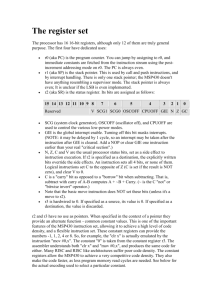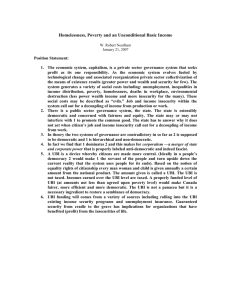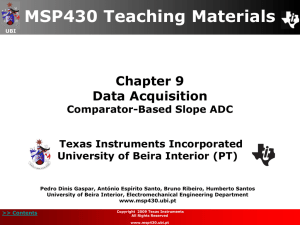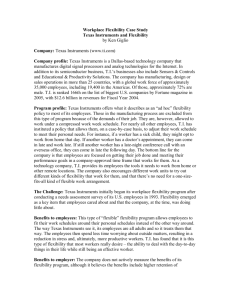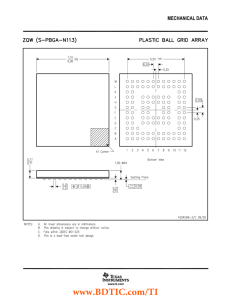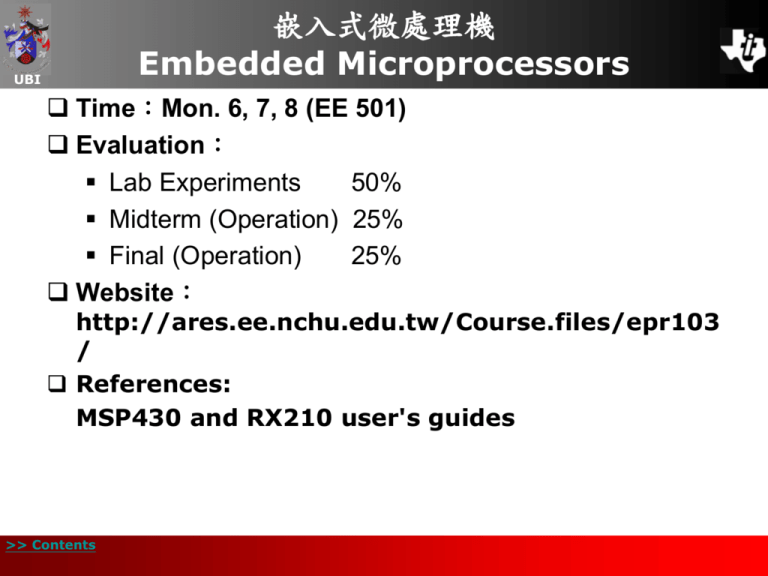
嵌入式微處理機
Embedded Microprocessors
UBI
Time:Mon. 6, 7, 8 (EE 501)
Evaluation:
Lab Experiments
50%
Midterm (Operation) 25%
Final (Operation)
25%
Website:
http://ares.ee.nchu.edu.tw/Course.files/epr103
/
References:
MSP430 and RX210 user's guides
>> Contents
Outline
UBI
Introductory Overview
MSP430 Architecture
General purpose Input/Output
Device Systems and Operating Modes
Timers
Data Acquisition
Digital-to-Analogue Converter
Direct Memory Access (DMA)
Hardware Multiplier
Communications
>> Contents
MSP430 Teaching Materials
UBI
Introductory Overview
>> Contents
Copyright 2009 Texas Instruments
All Rights Reserved
w.msp430.ubi.pt
Contents
UBI
MSP430 Integrated Development Environments (IDEs)
MSP430 Experimenter’s board
eZ430-F2013
MSP-EXP430F5438
Wireless expansion (Chipcon’s RF transceiver chip)
MSP-FET430 Flash Emulation Tool
How to read technical datasheets
>> Contents
Copyright 2009 Texas Instruments
All Rights Reserved
www.msp430.ubi.pt
4
MSP430 IDEs (1/2)
UBI
Main characteristics of the MSP430 Integrated
Development Environments (IDEs);
Available both from TI and third parties;
Special attention will be given to:
Code Composer Essentials v3;
IAR Embedded Workbench (EWB) IDE.
Using an IDE:
Basic functions;
Step by step project development;
• Structure and management (source files; compiling,
assembling and linking operations) of projects developed
both in C and/or Assembly language.
>> Contents
5
Copyright 2009 Texas Instruments
All Rights Reserved
MSP430 IDEs (2/2)
UBI
A range of software tools are available for the
generation of MSP430 source code:
Code Composer Essentials (TI)
IAR EWB - Kickstart ed. (IAR Systems);
CrossStudio (Rowley Associates);
MSPGCC (open-source comunity)...
SwiftX (Forth, Inc.);
HI-TECH (HI-TECH software);
ANSI C (ImageCraft);
Project-430 (Phyton, Inc.);
AQ430 (Quadravox);
…
>> Contents
6
Copyright 2009 Texas Instruments
All Rights Reserved
Code Composer Essentials v3 (1/2)
UBI
TI’s MSP430 IDE:
It is available as:
A free upgrade for existing v2 users;
Professional version ($499), the main features being:
• Unlimited code size;
• Can be ordered from the MSP430 web page;
• Supported by TI Software Support.
Evaluation Version (Free):
• 16 kB Limit on C/ASM code size;
• Download from MSP430 web page;
• Supported by TI Software Support.
>> Contents
7
Copyright 2009 Texas Instruments
All Rights Reserved
Code Composer Essentials v3 (2/2)
UBI
New features include:
Free 16 kB code-limited version;
Support for large memory model (Place data >64k);
Enhanced Compatibility with IAR C-code:
#pragma (ISR declarations), most intrinsics;
GDB Debugger replaced by TI proprietary debugger that
allows faster single stepping;
Hardware Multiplier libraries (16 bits and 32 bits);
CCE v2 project support (auto convert);
Breakpoints:
• EEM support via unified breakpoint manager;
• Use of Enhanced Emulation Module (EEM), with
predefined Use Cases;
• Unlimited Breakpoints.
>> Contents
8
Copyright 2009 Texas Instruments
All Rights Reserved
Starter kit: Experimenter’s board
UBI
Features:
MSP430F2013;
MSP430F5438;
Compatible with TI’s wireless
evaluation modules.
Combining 2 MCUs provides
nearly every MSP430 peripherals
available.
Needs a MSP-FET430 for development
>> Contents
9
Copyright 2009 Texas Instruments
All Rights Reserved
Starter kit: eZ430-F2013
UBI
All 14 input/output pins on the MSP430F2013 are
accessible on the MSP-EZ430D target board for easy
debugging and interfacing to peripherals;
One of these input/output pins is connected to an LED
for visual feedback;
Device features and integrated peripherals:
16-MIPS performance;
16-bit Sigma Delta ADC;
16-bit timer;
Watchdog timer;
Brownout detector;
USI module supporting SPI and I2C;
5 low power modes (0.5 μA standby).
>> Contents
10
Copyright 2009 Texas Instruments
All Rights Reserved
Starter kit: MSP-EXP430F5438 (1/5)
UBI
MSP-EXP430F5438:
MSP430F5438.
New features:
Power Management Module (PMM);
Unified Clock System (UCS);
System (SYS) modules;
Expanded memory/peripheral mapping
Peripheral module enhancements.
Enhanced performance
20 bit address capability;
32 bit Hardware Multiplier.
This board provides the wide range of F5438 peripherals.
>> Contents
11
Copyright 2009 Texas Instruments
All Rights Reserved
Starter kit: MSP-EXP430F5438 (2/5)
UBI
Device features and integrated peripherals
Device: MSP430F5438:
• 256 kB + 512 kB flash memory; 16 kB RAM.
>> Contents
Integrated peripherals:
• Three 16-bit timers;
• 12-bit SAR Analogue-to-Digital Converter;
• Direct Memory Access (DMA);
• Hardware multiplier (supporting 32-Bit operations);
• Universal Serial Communication Interfaces (USCI):
Enhanced UART Supporting Auto-Baudrate; IrDA
Encoder and Decoder; Synchronous SPI; I2C™;
• Real time clock module with alarm capabilities;
• Temperature sensor;
• Up to 87 I/O pins.
12
Copyright 2009 Texas Instruments
All Rights Reserved
Starter kit: MSP-EXP430F5438 (3/5)
UBI
The MSP430F5438 supports I2C and SPI protocols using
the USCI and the USI peripherals;
This protocol is used for inter-processor communication;
The link can be disconnected in hardware allowing these
peripherals to be used for other communication purposes.
Programming and Debugging:
Can be programmed using any MSP430 Flash Emulation
Tool (MSP-FET430xIF);
Wireless expansion:
Compatible with TI Wireless CCxxxXEMK Evaluation
Modules, such as the CC2500EMK.
Compatible with TI eZ-RF2500.
>> Contents
13
Copyright 2009 Texas Instruments
All Rights Reserved
Starter kit: MSP-EXP430F5438 (4/5)
UBI
The demo board has various system clock options that
support low and high frequencies.
The MSP430F5438 has integrated an Unified Clock
System that provides different clock sources:
Three low-frequency sources:
• LFXT1;
• Internal Very Low Power/Low Frequency Oscillator (VLO);
• Internal Reference Oscillator (REFO).
Internal Digitally Controlled Oscillator (DCO) / Frequency
Locked Loop (FLL) for highspeed operation:
• FLL reference selectable from LFXT1, REFO, or XT2.
ACLK/SMCLK/MCLK can all be driven from any source;
Dedicated MODOSC (internal) used for modules like Flash
controller, ADC, among others.
>> Contents
14
Copyright 2009 Texas Instruments
All Rights Reserved
Starter kit: MSP-EXP430F5438 (5/5)
UBI
MSP-EXP430F5438 demo board jumper and connectors
locations:
>> Contents
15
Copyright 2009 Texas Instruments
All Rights Reserved
Wireless expansion (Chipcon’s RF
transceiver chip)
UBI
CC2500EMK Evaluation Module 2.4 GHz:
The CC2500EM evaluation modules are provided with
antennas;
These evaluation modules are add-on daughter boards that
require a CC2500 development kit for evaluation and
development;
It allows to do range testing (PER testing) and transfer data
from one PC to another using the SmartRF®04DK, in order to
evaluate how well the SmartRF®04 products fit the intended
application;
It allows performing RF measurements.
>> Contents
16
Copyright 2009 Texas Instruments
All Rights Reserved
MSP-FET430 Flash Emulation Tool (1/2)
UBI
The flash emulation tool (FET) allow the application
development on the MSP430 MCU;
There are available two debugging interfaces:
USB port: MSP-FET430UIF;
Parallel port: MSP-FET430PIF.
MSP-FET430UIF flash emulation tool:
>> Contents
17
Copyright 2009 Texas Instruments
All Rights Reserved
MSP-FET430 Flash Emulation Tool (2/2)
UBI
Are used to program and debug the MSP430 in-system
through the:
4-wire JTAG interface: MSP-FET430PIF and MSP-FET430UIF;
2-wire JTAG interface (Spy Bi-Wire): MSP-FET430UIF.
These debugging tools interface the previously presented
MSP430 hardware development tools to the included
integrated software environment (CCE or IAR) and
include code to start an application.
Both MSP-FET430 supports development with all MSP430
flash devices.
>> Contents
18
Copyright 2009 Texas Instruments
All Rights Reserved
How to Read Datasheets (1/6)
UBI
Manufacturers of electronic components provide
datasheets containing the specifications detailing the
part/device characteristics;
Datasheets give the electrical characteristics of the
device and the pin-out functions, but without detailing
the internal operation;
More complex devices are provided with documents that
aid the development of applications, such as:
Application notes;
User's guides;
Designer's guides;
Package drawings, etc…
>> Contents
Copyright 2009 Texas Instruments
All Rights Reserved
www.msp430.ubi.pt
19
How to Read Datasheets (2/6)
UBI
Datasheets include information:
Concerning the part number of the device or device series;
Electrical characteristics:
• Maximum and minimum operating voltages;
• Operating temperature range e.g. 0 to 70 degrees C;
• Output drive capacity for each output pin, as well as an
overall limit for the entire chip;
• Clock frequencies;
• Pin out electrical characteristics (capacitance, inductance,
resistance);
• Noise tolerance or the noise generated by the device
itself;
• Physical tolerances…
>> Contents
Copyright 2009 Texas Instruments
All Rights Reserved
www.msp430.ubi.pt
20
How to Read Datasheets (3/6)
UBI
MSP430 device datasheet:
Device has a large number of peripherals;
Each input/output pin usually has more than one function;
It has a table with the description of each pin function;
Example, Pin number 2 = P6.3/A3;
• Digital Input/Output Port 6 bit 3;
• 3rd analogue input.
>> Contents
Copyright 2009 Texas Instruments
All Rights Reserved
www.msp430.ubi.pt
21
How to Read Datasheets (4/6)
UBI
MSP430 User’s Guide:
Most peripherals are represented by Block Diagrams.
Example: Part of the MSP430F44x clock module block
diagram:
>> Contents
Copyright 2009 Texas Instruments
All Rights Reserved
www.msp430.ubi.pt
22
How to Read Datasheets (5/6)
UBI
MSP430 User’s Guide:
Example: Part of the MSP430F44x clock module block diagram:
Detail SELMx;
Multiplexed block: (4 inputs and 1 output):
• SELMx = 00: Output routed to the 1st multiplexer output;
• SELMx = 01: Output routed to the second one and so on;
• SELMx is a 2-bit mnemonic: SELM1 (MSB), SELM0 (LSB).
To use the peripheral, it is necessary to find out how the
register(s) need to be configured:
• SELMx is in the FLL_CTL1 register.
>> Contents
Copyright 2009 Texas Instruments
All Rights Reserved
www.msp430.ubi.pt
23
How to Read Datasheets (6/6)
UBI
MSP430 User’s Guide:
SELMx are the 3rd and 4th bits of FLL_CTL1 control register.
FLL_CTL1, FLL+ control register 1
7
6
5
-
SMCLKOFF
XT2OFF
Bit
4
3
2
SELMx
SELS
1
0
FLL_DIVx
Description
6
SMCLKOFF
Disable the submain clock signal (SMCLK):
SMCLKOFF = 0
SMCLKOFF = 1
SMCLK active
SMCLK inactive
5
XT2OFF
Disable the second crystal oscillator (XT2):
XT2OFF = 0
XT2OFF = 1
XT2 active
XT2 inactive
4-3
SELMx
Select the master clock (MCLK) source:
SELM1 SELM0 = 0 0
SELM1 SELM0 = 0 1
SELM1 SELM0 = 1 0
SELM1 SELM0 = 1 1
2
SELS
Select the submain clock (SMCLK) source:
SELS = 0
DCO
SELS = 1
XT2
1-0
FLL_DIVx
Select the auxiliary clock (ACLK) signal divider:
FLL_DIV_0 = 0 0
Divider
FLL_DIV_1 = 0 1
Divider
FLL_DIV_2 = 1 0
Divider
FLL_DIV_3 = 1 1
Divider
>> Contents
DCO
DCO
XT2
LFXT1
factor:
factor:
factor:
factor:
Copyright 2009 Texas Instruments
All Rights Reserved
www.msp430.ubi.pt
/1
/2
/4
/8
24
Good software practices for low power
consumption (1/2)
UBI
C coding tips:
Use local variable as much as possible (Local variables use
CPU registers whereas global variables use RAM);
Use unsigned data types where possible;
Use pointers to access structures and unions;
Use “static const” class to avoid run-time copying of
structures, unions, and arrays;
Avoid modulo;
Count down “for” loops.
>> Contents
Copyright 2009 Texas Instruments
All Rights Reserved
www.msp430.ubi.pt
25
Good software practices for low power
consumption (2/2)
UBI
Principles for low power applications:
Maximize the time in standby;
Use interrupts to control program flow;
Replace software functions with peripheral hardware;
Manage the power of internal peripherals;
Manage the power of external devices;
Device choice can make a difference;
Effective code is a must. Every unnecessary instruction
executed is a portion of the battery wasted that will never
return.
>> Contents
Copyright 2009 Texas Instruments
All Rights Reserved
www.msp430.ubi.pt
26
MSP430 Teaching Materials
UBI
MSP430 Architecture
Texas Instruments Incorporated
University of Beira Interior (PT)
Pedro Dinis Gaspar, António Espírito Santo, Bruno Ribeiro, Humberto Santos
University of Beira Interior, Electromechanical Engineering Department
www.msp430.ubi.pt
>> Contents
Copyright 2009 Texas Instruments
All Rights Reserved
www.msp430.ubi.pt
Contents
UBI
MSP430 architecture:
Main characteristics
Architecture topology
Address space
Interrupt vector table
Central Processing Unit (MSP430 CPU)
Central Processing Unit (MSP430X CPU)
Addressing modes
Instructions set
>> Contents
28
Copyright 2009 Texas Instruments
All Rights Reserved
Introduction
UBI
A comprehensive description of the MSP430 architecture,
covering its:
Main characteristics;
Device architecture;
Address space;
Interrupt vector table;
Central Processing Unit (MSP430 CPU and MSP430X CPU);
7 seven addressing modes and instruction set composed of:
• 27 base opcodes;
• 24 emulated instructions.
>> Contents
29
Copyright 2009 Texas Instruments
All Rights Reserved
Microcontroller characteristics
UBI
Integration: Able to implement a whole design onto a single
chip.
Cost: Are usually low-cost devices (a few $ each);
Clock frequency: Compared with other devices
(microprocessors and DSPs), MCUs use a low clock frequency:
MCUs today run up to 100 MHz/100 MIPS (Million
Instructions Per Second).
Power consumption: Low power (battery operation);
Bits: 4 bits (older devices) to 32 bits devices;
Memory: Limited available memory, usually less than 1 MByte;
Input/Output (I/O): Low to high (8 to 150) pin-out count.
>> Contents
30
Copyright 2009 Texas Instruments
All Rights Reserved
MSP430 main characteristics (1/3)
UBI
Low power consumption:
0.1 A for RAM data retention;
0.8 A for real-time clock mode operation;
250 A/MIPS during active operation.
Low operation voltage (from 1.8 V to 3.6 V);
< 1 s clock start-up;
< 50 nA port leakage;
Zero-power Brown-Out Reset (BOR).
>> Contents
31
Copyright 2009 Texas Instruments
All Rights Reserved
MSP430 main characteristics (2/3)
UBI
On-chip analogue features:
10/12/16-bit Analogue-to-Digital Converter (ADC);
12-bit dual Digital-to-Analogue Converter (DAC);
Comparator-gated timers;
Operational Amplifiers (Op Amps);
Supply Voltage Supervisor (SVS).
16 bit RISC CPU:
Compact core design reduces power consumption and cost;
16-bit data bus;
27 core instructions;
7 addressing modes;
Extensive vectored-interrupt capability.
>> Contents
32
Copyright 2009 Texas Instruments
All Rights Reserved
MSP430 main characteristics (3/3)
UBI
Flexibility:
Up to 256 kByte Flash;
Up to 100 pins;
USART, I2C, Timers;
LCD driver;
Embedded emulation;
And many more peripherals modules…
Microcontroller performance:
Instruction processing on either bits, bytes or words
Reduced instructions set;
Compiler efficient;
Wide range of peripherals;
Flexible clock system.
>> Contents
33
Copyright 2009 Texas Instruments
All Rights Reserved
MSP430 Architecture
UBI
Block diagram:
>> Contents
34
Copyright 2009 Texas Instruments
All Rights Reserved
Address Space
UBI
Mapped into a single, contiguous address space:
Flash/ROM: All code, tables, and hard-coded constants
reside in this memory space.
Information memory: Variables needed for the next
power up can be stored here during power down. It can also
be used as code memory.
Boot memory: The bootstrap loader performs some of the
same functions as the JTAG interface.
RAM: RAM is used for both code and data.
Peripheral Modules: Peripheral modules consist of all onchip peripheral registers that are mapped into the address
space.
Special Function Registers (SFRs): Some peripheral
functions are mapped into memory with special dedicated
functions.
>> Contents
35
Copyright 2009 Texas Instruments
All Rights Reserved
Memory Map
UBI
Memory Address
End:
0FFFFh
Start:
0FFE0h
End:
0FFDFh
Description
Interrupt Vector Table
Flash/ROM
Start *:
End *:
Start:
End:
Start:
End *:
Start:
End:
Start:
End:
Start:
End:
Start:
>> Contents
0F800h
01100h
010FFh
0107Fh
01000h
0FFFh
0C00h
09FFh
027Fh
0200h
01FFh
0100h
00FFh
0010h
000Fh
0000h
Access
Word/Byte
Word/Byte
Information Memory
(Flash devices only)
Boot Memory
(Flash devices only)
Word/Byte
RAM
Word/Byte
Word/Byte
16-bit Peripheral modules
Word
8-bit Peripheral modules
Byte
Special Function Registers
Byte
36
Copyright 2009 Texas Instruments
All Rights Reserved
Interrupt vector table
UBI
Mapped at the very end of memory space (upper 16
words of Flash/ROM): 0FFE0h - 0FFFEh (4xx devices);
Priority of the interrupt vector increases with the word
address.
>> Contents
37
Copyright 2009 Texas Instruments
All Rights Reserved
Central Processing Unit (MSP430 CPU) (1/7)
UBI
RISC (Reduced Instructions Set Computing) architecture:
Instructions are reduced to the basic ones (short set):
• 27 physical instructions;
• 24 emulated instructions.
This provides simpler and faster instruction decoding;
Interconnect by using a common memory address bus
(MAB) and memory data bus (MDB) - Von Neumann
architecture:
• Makes use of only one storage structure for data and
instructions sets.
• The separation of the storage processing unit is implicit;
• Instructions are treated as data (programmable).
>> Contents
38
Copyright 2009 Texas Instruments
All Rights Reserved
Central Processing Unit (MSP430 CPU) (2/7)
UBI
RISC (Reduced Instructions Set Computing) type
architecture:
Uses a 3-stage instruction pipeline containing:
• Instruction decoding;
• 16 bit ALU;
• 4 dedicated-use registers;
• 12 working registers.
Address bus has 16 bit so it can address 64 kB (including
RAM + Flash + Registers);
Arithmetic Logic Unit (ALU):
Addition, subtraction, comparison and logical (AND, OR,
XOR) operations;
Operations can affect the overflow, zero, negative, and carry
flags of the SR (Status Register).
>> Contents
39
Copyright 2009 Texas Instruments
All Rights Reserved
Central Processing Unit (MSP430 CPU) (3/7)
UBI
Incorporates sixteen 16-bit registers:
• 4 registers (R0, R1, R2 and R3) have dedicated functions;
• 12 register are working registers (R4 to R15) for general
use.
R0: Program Counter (PC):
Points to the next instruction to be read from memory and
executed by the CPU.
R1: Stack Pointer (SP):
1st: stack can be used by user to store data for later use
(instructions: store by PUSH, retrieve by POP);
2nd: stack can be used by user or by compiler for subroutine
parameters (PUSH, POP in calling routine; addressed via offset
calculation on stack pointer (SP) in called subroutine);
>> Contents
40
Copyright 2009 Texas Instruments
All Rights Reserved
Central Processing Unit (MSP430 CPU) (4/7)
UBI
R1: Stack Pointer (SP) (continued):
3rd: used by subroutine calls to store the program counter
value for return at subroutine's end (RET);
4th: used by interrupt - system stores the actual PC value
first, then the actual status register content (on top of stack)
on return from interrupt (RETI) the system get the same
status as just before the interrupt happened (as long as none
has changed the value on TOS) and the same program
counter value from stack.
>> Contents
41
Copyright 2009 Texas Instruments
All Rights Reserved
Central Processing Unit (MSP430 CPU) (5/7)
UBI
R2: Status Register (SR):
Stores status and control bits;
System flags are changed automatically by the CPU;
Reserved bits are used to support the constant generator.
15
14
13
12
11
10
9
8
Reserved for CG1
Bit
7
V
6
SCG1
SCG0
5
OSCOFF
4
3
CPUOFF
GIE
2
N
1
Z
0
C
Description
8
V
Overflow bit. V = 1 Result of an arithmetic operation overflows the signed-variable range.
7
SCG1
System clock generator 0. SCG1 = 1
DCO generator is turned off – if not used for MCLK or SMCLK
6
SCG0
System clock generator 1. SCG0 = 1
FLL+ loop control is turned off
5
OSCOFF
Oscillator Off. OSCOFF = 1
4
CPUOFF
CPU off. CPUOFF = 1
3
GIE
General interrupt enable. GIE = 1
2
N
Negative flag. N = 1
1
Z
Zero flag. Z = 1
result of a byte or word operation is 0.
0
C
Carry flag. C = 1
>> Contents
turns off LFXT1 when it is not used for MCLK or SMCLK
disable CPU core.
enables maskable interrupts.
result of a byte or word operation is negative.
result of a byte or word operation produced a carry.
42
Copyright 2009 Texas Instruments
All Rights Reserved
Central Processing Unit (MSP430 CPU) (6/7)
UBI
R2/R3: Constant Generator Registers (CG1/CG2):
Depending of the source-register addressing modes (As)
value, six constants can be generated without code word or
code memory access to retrieve them.
This is a very powerful feature which allows the
implementation of emulated instructions, for example,
instead of implement a core instruction for an increment the
constant generator is used.
Register
As
Constant
Remarks
R2
00
-
Register mode
R2
(0)
R2
01
10
00004h
Absolute mode
+4, bit processing
R2
11
00008h
+8, bit processing
R3
00000h
R3
R3
00
01
10
00001h
00002h
0, word processing
+1
+2, bit processing
R3
11
0FFFFh
-1, word processing
>> Contents
Copyright 2008 43
Texas Instruments
All Rights Reserved
www.msp430.ubi.pt
43
Copyright 2009 Texas Instruments
All Rights Reserved
Central Processing Unit (MSP430 CPU) (7/7)
UBI
R4 - R15: General–Purpose Registers:
These general-purpose registers are adequate to store data
registers, address pointers, or index values and can be
accessed with byte or word instructions.
>> Contents
Copyright 2008 44
Texas Instruments
All Rights Reserved
www.msp430.ubi.pt
44
Copyright 2009 Texas Instruments
All Rights Reserved
UBI
Central Processing Unit (MSP430X CPU)
(1/10)
Main features of the MSP430X CPU architecture:
The MSP430X CPU extends the addressing capabilities of the
MSP430 family beyond 64 kB to 1 MB;
To achieve this, some changes have been made to the
addressing modes and two new types of instructions have
been added;
One instruction type allows access to the entire address
space, and the other is designed for address calculations;
The MSP430X CPU address bus has 20 bits, although the
data bus still has 16 bits. Memory accesses to 8-bit, 16-bit
and 20-bit data are supported;
Despite these changes, the MSP430X CPU remains
compatible with the MSP430 CPU, having a similar number
of registers.
>> Contents
45
Copyright 2009 Texas Instruments
All Rights Reserved
UBI
Central Processing Unit (MSP430X CPU)
(2/10)
Organization of the MSP430X CPU:
Although the MSP430X CPU structure is
similar to that of the MSP430 CPU, there
are some differences that will now be
highlighted;
With the exception of the status register
SR, all MSP430X registers are 20 bits;
The CPU can now process 20-bit or 16bit data.
>> Contents
46
Copyright 2009 Texas Instruments
All Rights Reserved
UBI
Central Processing Unit (MSP430X CPU)
(3/10)
The MSP430X CPU has 16 registers, some of which have
special use:
R0 (PC) Program Counter:
Has the same function as the MSP430 CPU, although now it
has 20 bits.
R1 (SP) Stack Pointer:
Has the same function as the MSP430 CPU, although now it
has 20 bits.
R2 (SR) Status Register:
Has the same function as the MSP430 CPU, but it still has 16
bits.
>> Contents
47
Copyright 2009 Texas Instruments
All Rights Reserved
UBI
Central Processing Unit (MSP430X CPU)
(4/10)
R2 (SR) Status Register:
Description of the SR bits:
>> Contents
48
Copyright 2009 Texas Instruments
All Rights Reserved
UBI
Central Processing Unit (MSP430X CPU)
(5/10)
R2 (SR/CG1) and R3 (CG2) Constant Generators:
Registers R2 and R3 can be used to generate six different
constants commonly used in programming, without adding
an additional 16-bit word to the instruction;
The constants are fixed and are selected by the (As) bits of
the instruction. (As) selects the addressing mode.
Values of constants
generated:
>> Contents
49
Copyright 2009 Texas Instruments
All Rights Reserved
UBI
Central Processing Unit (MSP430X CPU)
(6/10)
R2 (SR/CG1) and R3 (CG2) Constant Generators:
Whenever the operand is one of the six constants, the
registers are selected automatically;
Therefore, when used in constant mode, registers R2 and R3
cannot be used as source registers.
R4-R15 – General-purpose registers:
Have the same function as in the MSP430 CPU, although
they now have 20 bits;
These registers can process 8-bit, 16-bit or 20-bit data;
If a byte is written to one of these registers it takes bits 7:0,
the bits 19:8 are filled with zeroes. If a word is written to
one of these registers it takes bits 15:0, the bits 19:16 are
filled with zeroes.
>> Contents
Copyright 2009 Texas Instruments
All Rights Reserved
www.msp430.ubi.pt
50
UBI
Central Processing Unit (MSP430X CPU)
(7/10)
R4-R15 – General-purpose registers:
Handling byte data (8 bits) using the suffix .B:
>> Contents
Copyright 2009 Texas Instruments
All Rights Reserved
www.msp430.ubi.pt
51
UBI
Central Processing Unit (MSP430X CPU)
(8/10)
R4-R15 – General-purpose registers:
Handling word data (16 bits) using the suffix .W:
>> Contents
52
Copyright 2009 Texas Instruments
All Rights Reserved
UBI
Central Processing Unit (MSP430X CPU)
(9/10)
R4-R15 – General-purpose registers:
Manipulation of a 20-bit address using the suffix .A:
>> Contents
53
Copyright 2009 Texas Instruments
All Rights Reserved
Addressing modes
UBI
7 addressing modes for the source operand:
4 addressing modes for the destination operand:
Register mode; Indexed mode; Symbolic mode; Absolute
mode.
For the destination operand, two additional addressing
modes can be emulated.
>> Contents
54
Copyright 2009 Texas Instruments
All Rights Reserved
Instruction set
UBI
27 core instructions;
24 emulated instructions;
The instruction set is orthogonal;
The core instructions have unique opcodes decoded by
the CPU, while the emulated ones need assemblers and
compilers for their mnemonics;
There are three core-instruction formats:
Double operand;
Single operand;
Program flow control - Jump.
>> Contents
55
Copyright 2009 Texas Instruments
All Rights Reserved
MSP430 Teaching Materials
UBI
General Purpose Input/Output
Texas Instruments Incorporated
University of Beira Interior (PT)
Pedro Dinis Gaspar, António Espírito Santo, Bruno Ribeiro, Humberto Santos
University of Beira Interior, Electromechanical Engineering Department
www.msp430.ubi.pt
>> Contents
Copyright 2009 Texas Instruments
All Rights Reserved
www.msp430.ubi.pt
Contents
UBI
I/O Introduction
I/O port registers
Interruptible ports
>> Contents
57
Copyright 2009 Texas Instruments
All Rights Reserved
I/O Introduction (1/3)
UBI
Up to ten 8-bit digital Input/Output (I/O) ports, P1 to P10
(depending on the MSP430 device);
I/O ports P1 and P2 have interrupt capability;
Each interrupt for these I/O lines can be individually
configured:
To provide an interrupt on a rising or falling edge;
All interruptible I/O lines source a single interrupt vector.
The available digital I/O pins for the hardware
development tools:
eZ430-F2013: 10 pins - Port P1 (8 bits) and Port P2 (2 bits);
eZ430-RF2500: 32 pins - Port P1 to P4 (8 bits);
Experimenter’s board: 80 pins – Port P1 to P10 (8 bits).
>> Contents
58
Copyright 2009 Texas Instruments
All Rights Reserved
I/O Introduction (2/3)
UBI
Each I/O port can be:
Programmed independently for each bit;
Combine input, output, and interrupt functionality;
Edge-selectable input interrupt capability for all 8 bits of
ports P1 and P2;
Read/write access to port-control registers is supported by
all two- or one-address instructions;
Individually programmable pull-up/pull-down resistor (2xx
family only).
>> Contents
59
Copyright 2009 Texas Instruments
All Rights Reserved
I/O Introduction (3/3)
UBI
The port pins can be individually configured as I/O for
special functions, such as:
USART – Universal Synchronous/Asynchronous
Receive/Transmit for serial data;
Input comparator for analogue signals;
Analogue-to-Digital converter;
Others functions (see specific datasheet for details).
>> Contents
60
Copyright 2009 Texas Instruments
All Rights Reserved
Registers (1/6)
UBI
Independent of the I/O port type (non-interruptible or
interruptible), the operation of the ports is configured
by user software, as defined by the following registers:
Direction Registers (PxDIR):
• Read/write 8-bit registers;
• Select the direction of the corresponding I/O pin,
regardless of the selected function of the pin (general
purpose I/O or as a special function I/O);
• For other module functions, must be set as required by
the other function.
• PxDIR configuration:
Bit = 1: the individual port pin is set as an output;
Bit = 0: the individual port pin is set as an input.
>> Contents
61
Copyright 2009 Texas Instruments
All Rights Reserved
Registers (2/6)
UBI
Input Registers (PxIN):
• When pins are configured as GPIO, each bit of these
read-only registers reflects the input signal at the
corresponding I/O pin;
• PxIN configuration:
Bit = 1: The input is high;
Bit = 0: The input is low;
• Tip: Avoid writing to these read-only registers because
it will result in increased current consumption.
>> Contents
62
Copyright 2009 Texas Instruments
All Rights Reserved
Registers (3/6)
UBI
Output Registers (PxOUT):
• Each bit of these registers reflects the value written to
the corresponding output pin.
• PxOUT configuration:
Bit = 1: The output is high;
Bit = 0: The output is low.
– Note: the PxOUT Register is read-write. This means
that the previous value written to it can be read
back and modified to generate the next output
signal.
>> Contents
63
Copyright 2009 Texas Instruments
All Rights Reserved
Registers (4/6)
UBI
Pull-up/down Resistor Enable Registers (PxREN):
• Only available for the 2xx family;
• Each bit of this register enables or disables the pullup/pull-down resistor of the corresponding I/O pin.
• PxREN configuration:
– Bit = 1: Pull-up/pull-down resistor enabled;
– Bit = 0: Pull-up/pull-down resistor disabled.
– When pull-up/pull-down resistor is enabled:
– In this case Output Registers (PxOUT) select:
» Bit = 1: The pin is pulled up;
» Bit = 0: The pin is pulled down.
>> Contents
64
Copyright 2009 Texas Instruments
All Rights Reserved
Registers (5/6)
UBI
Function Select Registers: (PxSEL) and (PxSEL2):
• Some port pins are multiplexed with other peripheral
module functions (see the device-specific datasheet);
• These bits: PxSEL and PxSEL2 (see specific device
datasheet), are used to select the pin function:
– I/O general purpose port;
– Peripheral module function.
• PxSEL configuration:
Bit = 0: I/O Function is selected for the pin;
Bit = 1: Peripheral module function enabled for pin.
>> Contents
65
Copyright 2009 Texas Instruments
All Rights Reserved
Registers (6/6)
UBI
Function Select Registers: (PxSEL) and (PxSEL2):
• The 2xx family of devices provide the PxSEL2 bit to
configure additional features of the device;
• The PxSEL and PxSEL2 bits in combination provide the
following configuration:
– Bit = 0: I/O function is selected for the pin;
– Bit = 1: Peripheral module function is selected for
the pin.
PxSEL
PxSEL2
Pin Function
0
0
Selects general purpose I/O function
0
1
Selects the primary peripheral module function
1
0
Reserved (See device-specific data sheet)
1
1
Selects the secondary peripheral module function
Note: P1 and P2 configured as peripheral module function (PxSEL = 1 and/or PxSEL2) -> interrupts disabled.
>> Contents
66
Copyright 2009 Texas Instruments
All Rights Reserved
Interruptible ports (P1 and P2)
(1/2)
UBI
Each pin of ports P1 and P2 is able to make an interrupt
request;
Pins are configured with additional registers:
Interrupt Enable (PxIE):
• Read-write register to enable interrupts on individual pins;
• PxIE configuration:
Bit = 1: The interrupt is enabled;
Bit = 0: The interrupt is disabled.
• Each PxIE bit enables the interrupt request associated with
the corresponding PxIFG interrupt flag;
• Writing to PxOUT and/or PxDIR can result in setting PxIFG.
>> Contents
67
Copyright 2009 Texas Instruments
All Rights Reserved
Interruptible ports (P1 and P2)
(2/2)
UBI
Interrupt Edge Select Registers (PxIES):
• Selects the transition on which an interrupt occurs (if PxIE
and GIE are set);
• PxIES configuration:
Bit = 1: Interrupt flag is set on a high-to-low transition;
Bit = 0: Interrupt flag is set on a low-to-high transition.
Interrupt Flag Registers (PxIFG)
• Set automatically when an the programmed signal
transition (edge) occurs;
• PxIFG flag can be set and must be reset by software.
• PxIFG configuration:
Bit = 0: No interrupt is pending;
Bit = 1: An interrupt is pending.
>> Contents
68
Copyright 2009 Texas Instruments
All Rights Reserved


